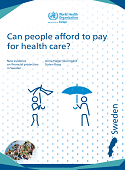Can people afford to pay for health care? New evidence on financial protection in Sweden (2019)

Download
By Anna Häger Glenngård, Sixten Borg
2019, xiv + 73 pages
ISBN 978 92 890 5465 2
This publication is only available online.
This review is part of a series of country-based studies generating new evidence on financial protection in European health systems. Financial protection is central to universal health coverage and a core dimension of health system performance.
The incidence of catastrophic health spending is low in Sweden compared to many countries in Europe due to relatively high levels of public spending on health, and health coverage policy carefully designed to protect children and adolescents from co-payments.
Catastrophic spending on health is concentrated among poor people. The drivers of financial hardship are dental care and medical products on average, but among the poorest quintile, the largest contributor to catastrophic spending is outpatient medicines. There is also substantial socioeconomic inequality in unmet need for dental care and prescribed medicines.
User charges (co-payments) are widespread in the Swedish health system. Although there are age-related exemptions and annual caps in place to protect some people from some co-payments, both policies could be improved. The results of this analysis suggest that more could be done to protect poor households, including action to lower access barriers and out-of-pocket payments for people receiving social benefits.



